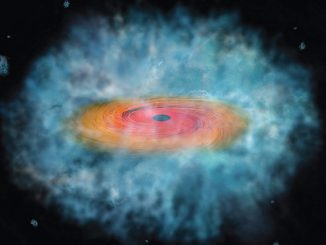
Astronomers using the Very Long Baseline Array (VLBA) radio telescope have captured an image of a powerful radio quasar shining at the dawn of the Universe some 13 billion years ago. Catalogued as PSO J352.4034-15.3373 – P352-15 for short – the quasar is one of only a handful of bright radio sources in the early Universe, giving astronomers a chance to study some of the more enigmatic processes at work in that remote epoch.
“There is a dearth of known strong radio emitters from the Universe’s youth, and this is the brightest radio quasar at that epoch by a factor of 10,” said Eduardo Banados of the Carnegie Institution for Science in Pasadena, California.
Emmanuel Momjian of the National Radio Astronomy Observatory (NRAO) said the VLBA observations represent “the most detailed image yet of such a bright galaxy at this great distance.,”
Quasars are thought to be galaxies featuring super-massive black holes in their cores with millions to billions of times the mass of the Sun. The unimaginable gravity of such black holes pulls in gas and dust, forming a rotating disk spewing jets of energetic particles that rush away at nearly the speed of light. They can be bright emitters of visible light and radio waves, which is the case with P352-15.

The VLBA imagery shows P352-15 is split into three major components stretching across 5,000 light years. Two explanations are possible, the astronomers say. The black hole could be in the central component, with two huge jets streaming away in opposite directions. Or, conversely, the black hole could be one of the end components with the other two features part of a single jet.
The latter option appears more likely because one of the components, presumably harbouring the black hole, is closest to the visible light location of P352-15. If so, astronomers may be able to measure the expansion of the jet over several years. If the middle object represents the black hole, its small size could indicate it’s very young or embedded in thick gas that is slowing down the jets.
Either way, “we are seeing P352-15 as it was when the Universe was less than a billion years old, or only about 7 percent of its current age,” said Chris Carilli, of NRAO. “This is near the end of a period when the first stars and galaxies were (lighting up and) re-ionising the neutral hydrogen atoms that pervaded intergalactic space. Further observations may allow us to use this quasar as a background ‘lamp’ to measure the amount of neutral hydrogen remaining at that time.”
The observations are reported in the Astrophysical Journal.
“This quasar’s brightness and its great distance make it a unique tool to study the conditions and processes that prevailed in the first galaxies in the Universe,” Carilli said. “We look forward to unraveling more of its mysteries.”



